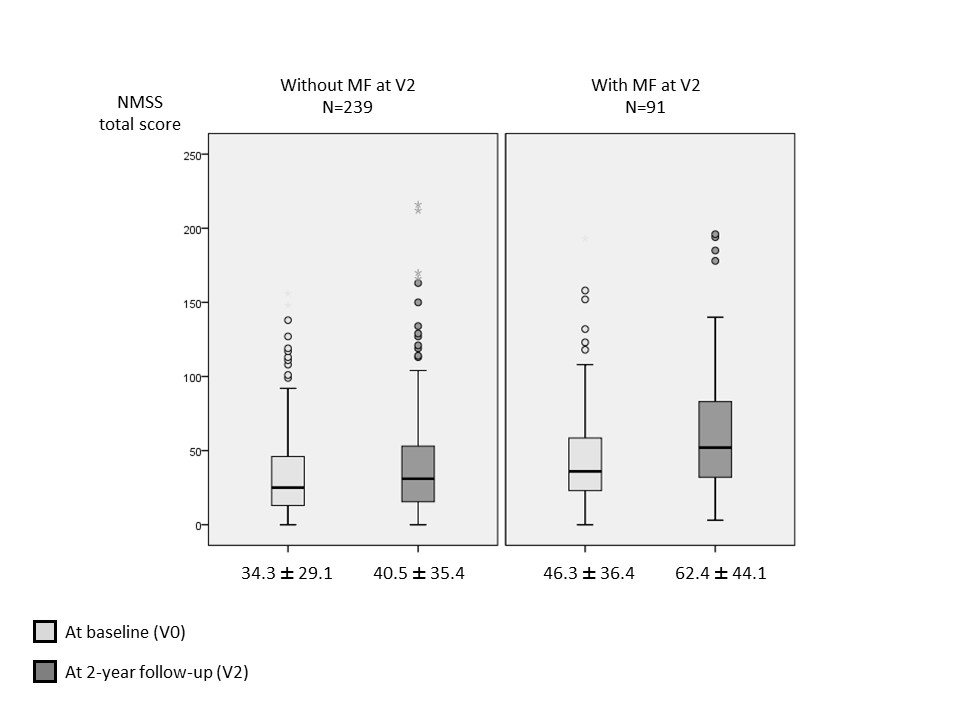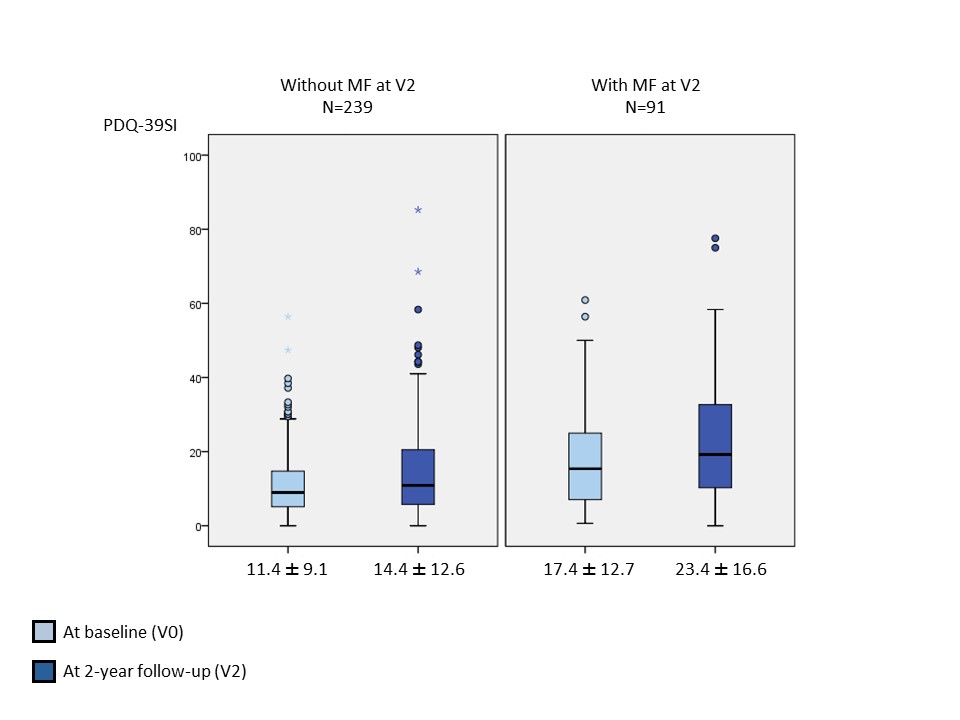Category: Parkinson's Disease: Non-Motor Symptoms
Objective: The aim of the present study was to analyze the progression of non-motor symptoms (NMS) burden in Parkinson´s disease (PD) patients regarding the development of motor fluctuations (MF). Moreover, the change in health-related quality of life (HR-QoL) was analyzed as well.
Background: Recently, we observed in a cross-sectional study that NMS burden is strongly correlated to motor complications in patients with PD [1].
Method: PD patients without MF at baseline, who were recruited from January/2016 to November/2017 (baseline visit; V0) and evaluated again at 2-year follow-up (V2; 24 months ± 1 month) from 35 centers of Spain from the COPPADIS cohort [2], were included in this analysis. MF development at V2 was defined as a score ≥ 1 in the item-39 of the Unified Parkinson´s Disease Rating Scale – Part IV (UPDRS-IV-item/39) whereas NMS burden according to the Non-Motor Symptoms Scale (NMSS) total score. The HR-QoL was assessed with the 39-item Parkinson’s disease Questionnaire (PDQ-39).
Results: Three hundred and thirty PD patients (62.6 ± 8.7 years old; 58.8% males) were included. From V0 to V2, 27.6% of the patients developed MF. The mean NMSS total score at baseline was higher in those patients who developed MF after the 2-year follow-up (46.3 ± 36.4 vs 34.3 ± 29.1; p=0.001) (Figure 1). A greater increase in the NMSS total score from V0 to V2 was observed in those patients who developed MF (+ 16.0 ± 37.3) compared to those who didn´t develop MF (+ 6.2 ± 25.8) (p=0.021). Similar results were observed in terms of HR-QoL (Figure 2). To develop MF after a 2-year follow-up was associated with an increase in the NMSS total score (β=0.137; p=0.025) after adjustment to age, gender, levodopa equivalent daily dose, years from symptoms onset and the NMSS total score at baseline.
Conclusion: In PD patients, the development of MF is associated with a greater increase in the NMS burden and HR-QoL impairment after a 2-year follow-up.
References: 1. Santos-García D, de Deus Fonticoba T, Suárez Castro E, et al.; COPPADIS Study Group, McAfee D. Non-motor symptom burden is strongly correlated to motor complications in patients with Parkinson’s disease. Eur J Neurol 2020;27:1210-23.
2. Santos-García D, Mir P, Cubo E, et al.; COPPADIS Study Group. COPPADIS-2015 (COhort of Patients with PArkinson’s DIsease in Spain, 2015), a global–clinical evaluations, serum biomarkers, genetic studies and neuroimaging–prospective, multicenter, non-interventional, long-term study on Parkinson’s disease progression. BMC Neurol 2016;16:26.
To cite this abstract in AMA style:
D. Santos, T. de Deus, C. Cores, M. Feal Painceiras, E. Suárez Castro, C. Martínez, S. Jesús, M. Aguilar, P. Pastor, L. Planellas, M. Cosgaya, J. García Caldentey, N. Caballol, I. Legarda, J. Hernández Vara, I. Cabo, L. López Manzanares, I. González Aramburu, M. Avila, V. Gómez Mayordomo, V. Nogueira, V. Puente, J. Dotor, C. Borrué, B. Solano, M. álvarez Sauco, L. Vela, S. Escalante, E. Cubo, F. Carrillo, J. Martínez Castrillo, P. Sánchez Alonso, M. Alonso Losada, N. López Ariztegui, I. Gastón, J. Kulisevsky, M. Blázquez, M. Seijo, J. Ruíz Martínez, C. Valero, M. Kurtis, O. de Fábregues, J. González, R. Alonso Redondo, C. Ordás, L. López Díaz, D. Mcafee, P. Martínez Martín, P. Mir, C. Coppadis. Motor Fluctuations development is associated with non-motor symptoms burden progression in Parkinson´s disease patients. A 2-year follow-up study. [abstract]. Mov Disord. 2022; 37 (suppl 2). https://www.mdsabstracts.org/abstract/motor-fluctuations-development-is-associated-with-non-motor-symptoms-burden-progression-in-parkinsons-disease-patients-a-2-year-follow-up-study/. Accessed December 28, 2025.« Back to 2022 International Congress
MDS Abstracts - https://www.mdsabstracts.org/abstract/motor-fluctuations-development-is-associated-with-non-motor-symptoms-burden-progression-in-parkinsons-disease-patients-a-2-year-follow-up-study/


